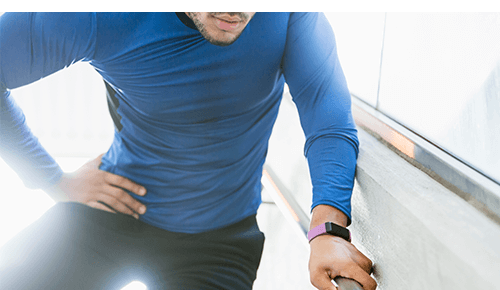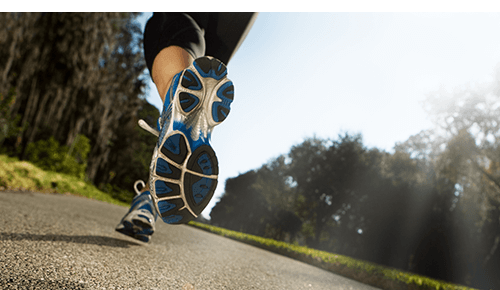Running feels like something that should come naturally. After all, we’ve been doing it since we were kids. It’s just one foot in front of the other, and the rest is cardiovascular and respiratory endurance, right?
Not exactly. Achieving greater distances and improving performance require efficiency of movement, and avoiding injury as your mileage climbs involves identifying and minimizing imbalances in your form.
Angelo Lamatrice, MPT, a physical therapist from the OhioHealth Sports Medicine Runner’s Clinic, and a physical therapist and athletic trainer for Otterbein University distance runners, provides tips for improving your run, and explains how physical therapy can up your running game.
Put your hips into it
“There is a strong correlation between hip weakness and lower extremity injuries,” says Lamatrice. Hip weakness gives you less control of how your hips move side-to-side, which can cause your knee and foot to rotate inward, or overpronate. “The stress from that misalignment then works its way back up the chain – plantar fasciitis, runner’s knee, IT band injuries, hip bursitis and low back pain.”
“When we work with runners at the Runner’s Clinic, we identify things like posture, flexibility and strength imbalances like hip weakness that we can isolate, correct and improve,” says Lamatrice. “Hip strength gives you a better platform to run from and can help you avoid injury. If you’re seeking to improve your performance, improved hip extension can give you a better flight phase to potentially improve your times.”
Concentrate on core
“Our bodies are task-dependent,” says Lamatrice. “They do what we ask them to do the way we ask them to do it. So, though you may have the ability to run, you could still be hiding weaknesses in your form that prevent you from accomplishing what you want to accomplish.”
He says as people age, he finds they generally have tightness in the muscles toward the front of their body, and weakness in the back. “What we want to do is create balance, get more power out of muscles like glutes and hamstrings.” Lamatrice says cross training can help achieve this balance. “A workout that includes exercises like planks, bridges, squats and lunges can begin to correct and improve any core imbalances you have.”
This is much of what Lamatrice and his colleagues focus on at the Runner’s Clinic. “Our job is not to focus on the ‘how far’ or the ‘how fast,’ but the ‘how.’ Identifying your needs and locking in your mechanics takes time, maybe a month and a half, but if you want to break through a plateau, it’s worth taking a minute to determine and address your specific needs.”
Work around injuries
Any runner, regardless of performance level, has likely experienced an injury. Though it’s a good idea to rest injured muscles and tendons, Lamatrice says it’s important not to disengage from activity altogether.
“When the runners I work with get injured, we find ways to manage their participation and keep them involved as they heal. It may be modifying distance or speed, or changing up their routine,” he says. “We rarely want them to stop completely – can we do the pool; can we do the bike – we don’t want to put runners in a boot and shut them down completely. We want to keep them active and motivated. And I would recommend the same for folks running on their own. Find a way to keep moving even if you can’t hit the road.”
If the shoe fits
“A lot of people will buy shoes based on trends, or whichever shoes are the cheapest in the store,” says Lamatrice. “But selecting the right shoe for your feet and running style is a very important part of getting the most out of your performance and protecting your body.” He says the Runner’s Clinic helps participants get fitted with proper footwear, “but any reputable running store has staff who can help you find the best shoe for you.”
A comprehensive physical, nutritional and biomechanics assessment by the team at OhioHealth Runner’s Clinic can help you reach the next level, complete your next race, or continue running healthy for years to come. Call (614) 566-1RUN to schedule an appointment.
Categories: Exercise, Physical Therapy, Sports Medicine
Series: Runner Talk







